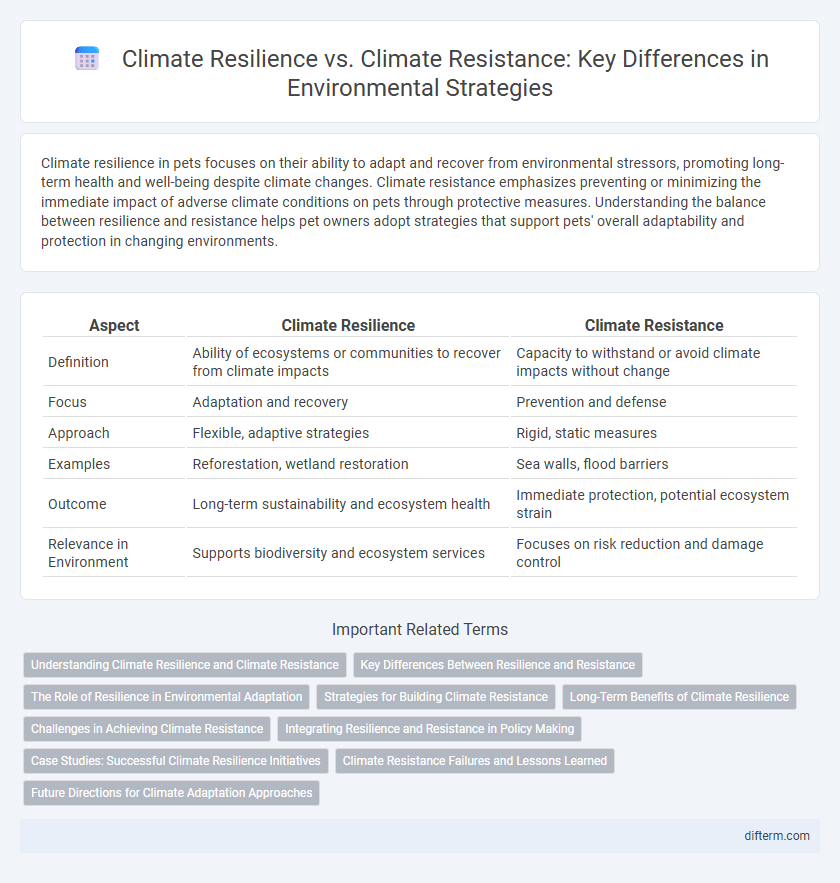Climate resilience in pets focuses on their ability to adapt and recover from environmental stressors, promoting long-term health and well-being despite climate changes. Climate resistance emphasizes preventing or minimizing the immediate impact of adverse climate conditions on pets through protective measures. Understanding the balance between resilience and resistance helps pet owners adopt strategies that support pets' overall adaptability and protection in changing environments.
Table of Comparison
| Aspect | Climate Resilience | Climate Resistance |
|---|---|---|
| Definition | Ability of ecosystems or communities to recover from climate impacts | Capacity to withstand or avoid climate impacts without change |
| Focus | Adaptation and recovery | Prevention and defense |
| Approach | Flexible, adaptive strategies | Rigid, static measures |
| Examples | Reforestation, wetland restoration | Sea walls, flood barriers |
| Outcome | Long-term sustainability and ecosystem health | Immediate protection, potential ecosystem strain |
| Relevance in Environment | Supports biodiversity and ecosystem services | Focuses on risk reduction and damage control |
Understanding Climate Resilience and Climate Resistance
Climate resilience refers to the ability of ecosystems and communities to recover from climate-related disturbances such as extreme weather events, while climate resistance involves minimizing the immediate impact of these events through robust infrastructure and adaptive measures. Building climate resilience emphasizes flexibility, learning, and adaptation to long-term climate variability, whereas climate resistance prioritizes prevention and protection against specific climate threats. Integrating both approaches enhances overall environmental sustainability and reduces vulnerability to climate change effects.
Key Differences Between Resilience and Resistance
Climate resilience involves the capacity of ecosystems and communities to absorb, recover, and adapt to climate impacts, ensuring long-term sustainability and functionality. Climate resistance emphasizes the ability to withstand and minimize immediate damage from climate stresses without significant change or adaptation. Key differences include resilience's focus on recovery and adaptation versus resistance's focus on prevention and rigidity.
The Role of Resilience in Environmental Adaptation
Climate resilience emphasizes the capacity of ecosystems and communities to absorb disturbances and reorganize while undergoing change to maintain critical functions. Unlike climate resistance, which aims to prevent change by maintaining existing conditions, resilience supports adaptive transformation in response to climate stressors such as rising temperatures, extreme weather events, and sea-level rise. This adaptive approach enhances long-term environmental sustainability by promoting flexibility, biodiversity, and recovery in vulnerable habitats.
Strategies for Building Climate Resistance
Climate resistance strategies emphasize reinforcing infrastructure and ecosystems to withstand extreme weather events, such as constructing flood barriers and enhancing stormwater management systems. These approaches prioritize immediate protection against climate impacts by using durable materials and engineering solutions that reduce vulnerability to hazards. Incorporating native plant species and restoring wetlands also strengthens natural defenses, providing sustainable buffers against floods and heatwaves.
Long-Term Benefits of Climate Resilience
Climate resilience emphasizes adaptive strategies that enable ecosystems and communities to recover from climate impacts, ensuring sustained functionality over decades. Investments in climate resilience promote biodiversity preservation, reduce disaster recovery costs, and enhance agricultural productivity despite changing weather patterns. This long-term approach supports sustainable development by minimizing vulnerabilities and fostering ecosystem services critical to human well-being.
Challenges in Achieving Climate Resistance
Achieving climate resistance faces significant challenges due to the increasing frequency and intensity of extreme weather events driven by global warming. Infrastructure often lacks the durability to withstand these evolving climate stressors, while economic and social disparities limit adaptive capacity across vulnerable communities. Furthermore, uncertainties in climate projections hinder the design of universally robust solutions, complicating efforts to build long-term resistance.
Integrating Resilience and Resistance in Policy Making
Integrating climate resilience and resistance in policy making enhances adaptive capacity to environmental stressors and minimizes vulnerability to climate impacts. Policies targeting resilience emphasize ecosystem recovery and flexible resource management, while resistance focuses on maintaining current conditions through protective infrastructure and mitigation strategies. Combining these approaches ensures comprehensive solutions that balance immediate defense with long-term sustainability in climate adaptation plans.
Case Studies: Successful Climate Resilience Initiatives
Case studies from Bangladesh demonstrate effective climate resilience through adaptive infrastructure like elevated homes and flood-resistant crops, reducing vulnerability to rising sea levels and extreme weather. In the Netherlands, the Room for the River program exemplifies climate resilience by redesigning floodplains to accommodate excess water, mitigating flood risk while preserving ecosystems. These initiatives highlight the success of climate resilience strategies that prioritize adaptation and ecosystem-based solutions over rigid climate resistance approaches.
Climate Resistance Failures and Lessons Learned
Climate resistance strategies often fail due to their reliance on rigid infrastructure and short-term fixes that do not accommodate evolving climate patterns and extreme weather events. Lessons learned emphasize the need for adaptive, flexible approaches that enhance ecological and social resilience rather than merely attempting to repel environmental changes. Effective climate resilience integrates natural systems management and community engagement, ensuring sustainable responses to ongoing and future climate stresses.
Future Directions for Climate Adaptation Approaches
Future directions for climate adaptation emphasize climate resilience, which enhances ecosystems' and communities' capacity to absorb shocks and recover, over climate resistance that aims to maintain current conditions. Integrating nature-based solutions, such as restoring wetlands and urban green spaces, supports adaptive systems that evolve with climate change impacts. Advances in climate modeling and real-time data analytics enable targeted, scalable interventions fostering long-term sustainability and reduced vulnerability.
climate resilience vs climate resistance Infographic

 difterm.com
difterm.com